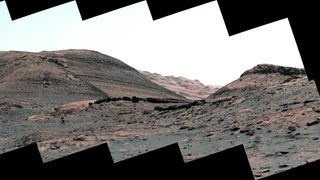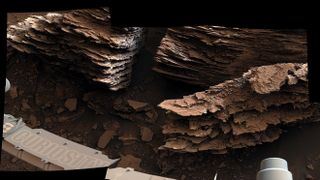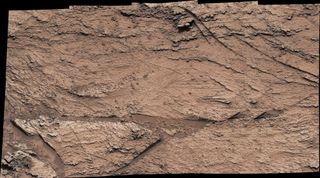Stunning Mars photos by the Curiosity rover show ancient climate shift
The rover is finding minerals formed amid drier conditions as it ascends Mount Sharp.

A venerable Red-Planet rover might be spotting signs of the Martian climate drying up in ancient times.
The long-running NASA Curiosity mission, which will reach its 10th Earth-year anniversary on the Red Planet this August, is making its way up the slopes of Mount Sharp (Aeolis Mons) to trace the changing climate of Mars over the eons. For about the past year of its roving, Curiosity has been noticing water-rich clay giving way to a transition zone filled with salty sulfate. Scientists currently believe those features mark where streams dried up and sand dunes formed, according to a NASA statement.
What this means is that lake deposits that populated the lower slopes are not as common as Curiosity reaches higher on the mountain. "Instead, we see lots of evidence of drier climates, like dry dunes that occasionally had streams running around them," Ashwin Vasavada, Curiosity's project scientist at JPL, said in the statement.
Related: 12 amazing photos from the Perseverance rover's 1st year on Mars
Besides more sulfate, geologic features are capturing the attention of scientists. They are seeing sediments likely deposited in stacks of "flaky layers," including one nicknamed "The Prow" by team members.
The region has a complex history, including a dry origin story as a sand dune-filled area and some zones that appear to have had sediments carried in by water, JPL stated.
"Making the story richer yet more complicated is the knowledge that there were multiple periods in which groundwater ebbed and flowed over time, leaving a jumble of puzzle pieces for Curiosity's scientists to assemble into an accurate timeline," officials added in the statement.
Get the Space.com Newsletter
Breaking space news, the latest updates on rocket launches, skywatching events and more!

While the rover is still operating well, JPL noted it is showing inevitable signs of age, notably holes on its aluminum wheels that have been navigating the Martian terrain in the years since Curiosity touched down on Aug. 5, 2012.
The left middle wheel, as shown in images taken June 2 this year, has more extensive damage and gaps to its grousers (treads). JPL said it is unlikely the grousers will completely disintegrate, but noted ground testing shows that at worst, the rover can drive on the rims of its wheels if necessary.

Curiosity also had a brief safe mode incident on June 7 after an unexpected temperature spike on an instrument control box. The rover exited safe mode two Earth days later, and team members are investigating the cause.
"They suspect safe mode was triggered after a temperature sensor provided an inaccurate measurement, and there's no sign it will significantly affect rover operations since backup temperature sensors can ensure the electronics within the rover body aren’t getting too hot," JPL stated.
Follow Elizabeth Howell on Twitter @howellspace. Follow us on Twitter @Spacedotcom or Facebook.
Join our Space Forums to keep talking space on the latest missions, night sky and more! And if you have a news tip, correction or comment, let us know at: community@space.com.

Elizabeth Howell (she/her), Ph.D., is a staff writer in the spaceflight channel since 2022 covering diversity, education and gaming as well. She was contributing writer for Space.com for 10 years before joining full-time. Elizabeth's reporting includes multiple exclusives with the White House and Office of the Vice-President of the United States, an exclusive conversation with aspiring space tourist (and NSYNC bassist) Lance Bass, speaking several times with the International Space Station, witnessing five human spaceflight launches on two continents, flying parabolic, working inside a spacesuit, and participating in a simulated Mars mission. Her latest book, "Why Am I Taller?", is co-written with astronaut Dave Williams. Elizabeth holds a Ph.D. and M.Sc. in Space Studies from the University of North Dakota, a Bachelor of Journalism from Canada's Carleton University and a Bachelor of History from Canada's Athabasca University. Elizabeth is also a post-secondary instructor in communications and science at several institutions since 2015; her experience includes developing and teaching an astronomy course at Canada's Algonquin College (with Indigenous content as well) to more than 1,000 students since 2020. Elizabeth first got interested in space after watching the movie Apollo 13 in 1996, and still wants to be an astronaut someday. Mastodon: https://qoto.org/@howellspace
